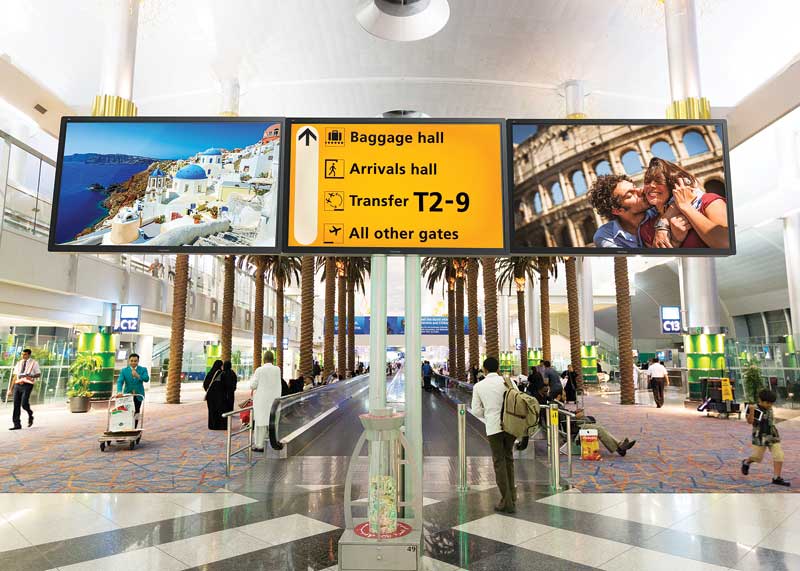Digital Signage: Current trends for dynamic displays
by all | 11 May 2018 9:15 am
 [1]
[1]Photos courtesy ViewSonic Canada
By Deidre Deacon
The past year has been a banner one for digital displays. Key categories for large-format and/or interactive displays outperformed previous years to deliver positive, double-digit growth across a growing number of sectors, from entertainment, retail and commercial to small businesses and education. According to research by MarketsandMarkets, the large-format dynamic display market is expected to experience a compound annual growth rate (CAGR) of 6.7 per cent between 2017 and 2023.
There are a number of reasons behind the strong growth trends. For one, digital signage is becoming an integral part of customer engagement, from spectacular, eye-catching dynamic posters and billboards to interactive screens that allow consumers to order food, check out product features or find their way around a facility. The medium is finding a home in almost all environments, from sports venues and subway stations to coffee shops, dental offices and art galleries.
For another, technological innovations have helped digital signage’s cause by making hardware more affordable and, thus, more accessible to a wider breadth of users. As displays become larger, they are also becoming lighter and offering greater functionality.
At the same time, digital signage network integration and content management have become less complex undertakings, thanks to today’s built-in capabilities and user-friendly software. Virtually any business can now program and manage its own digital signage content.
A growing number of non-commercial organizations, too, are making significant investments in new digital signage networks. Movingmedia, for example, is working on a project for the city of Peterborough, Ont., which will involve the installation of new screens in nine municipal facilities over the coming months, each of which will be customized with content for its specific audience. This market niche is expected to expand as more municipal governments also adopt the technology.
As the uptake in digital signage deployments continues throughout 2018, the following are a few of the top trends that will have significant effects on the market.
 [2]
[2]Support for ultra-high-definition (UHD) ‘4K’ content began in airports and other specialized venues before reaching consumers’ homes.
4K content
Ultra-high-definition (UHD) ‘4K’ on-screen content will continue to gain traction, in keeping with the demand for higher-resolution viewing experiences.
Since the earliest days of high-definition (HD) content, continual improvements have been made in image resolution. In the last few years, 4K has inched toward the mainstream for the TV, gaming and commercial markets for large-format displays.
Grand View Research, a business consulting firm, estimates the 4K TV market will be worth nearly US$381 billion by 2025, having experienced a CAGR of 21.2 per cent. And as consumers become accustomed to viewing 4K content in their homes, they will expect the same resolution quality from digital signage.
Whether or not a digital signage network is constantly streaming full 4K content, there is already a push on in the industry to ‘future-proof’ investments in display technology, ensuring they are ready for tomorrow’s video footage. For that matter, even when a UHD screen is not running true 4K content, it will still deliver noticeable improvements in image quality for existing content in a 16:9, 1,080-pixel aspect ratio.
It certainly helps that many of today’s large-format 4K displays do not carry a hefty price premium. (There are expensive exceptions for interactive flat panels and digital projection systems, however, due to their requirement for additional components.)
Stronger security
The rapid growth of the Internet of Things (IoT) has put a spotlight on the risks of hacking associated with connected devices and systems, ranging from surveillance cameras to household appliances. Digital signage can certainly be counted among the technologies at risk, with numerous recent examples of screens hacked to display obscene messages, and enhancing security has become critically important for all formats.
With the plethora of digital signs streaming live content, along with the increased integration of interactivity, back-end information technology (IT) infrastructure security has become a top priority. One of the most important factors to consider is how the vast majority of displays currently deployed in the marketplace are controlled by Google’s Android operating system (OS), which poses security concerns.
Technology vendors are working closely with security-focused partners to find more effective and efficient approaches to data protection and system management. Many are introducing built-in security chipsets that will simplify and strengthen security for digital signage networks in the near future, e.g. with enhanced, customizable system lockdown capabilities.
 [3]
[3]Interactive digital displays have become more accurate in tracking users’ movements.
Higher-speed connectivity
Ultra-high-speed connectivity, both physical and wireless, has become a critically important component for flat-panel displays, particularly when interactive. And each year, as content becomes higher-resolution (as mentioned earlier) and more complex, the need increases.
While wired connectivity will continue to be the predominant option, a growing interest in 5G wireless connectivity is opening additional opportunities for streaming content to screens. The next generation of digital displays will accommodate multiple inputs for out-of-the-box functionality, including physical Video Graphics Array (VGA) and HD Multimedia Interface (HDMI) ports and wireless antennas. Built-in casting capabilities will also allow users to stream content from any device without requiring additional hardware.
Enhanced interactivity
There has been exponential growth for touch screens in recent years. While many of today’s displays can handle basic interactivity, however, many users’ needs have become more advanced.
The number of touch points supported on a single panel, for example, has grown with the advent of large-scale video walls. It is now possible for 20 touch points on a display to allow multiple users to interact with content simultaneously.
The next phase of development will bring even more touch points and greater accuracy on larger-format displays, based on enhanced technologies originally developed for smartphones. These improvements will open the doors for new promotional and cross-marketing applications everywhere from movie theatres and hotel lobbies to automotive dealerships and restaurants.
Innovative projections
As the installation of public large-format displays grows, the digital projector market has shown new signs of life and made a comeback. In fact, some of the most interesting and innovative digital signage work seen these days has involved projection mapping of high-resolution images onto existing surfaces. Digital projectors are increasingly being used to display content at amusement parks and sports venues, among other large-scale environments, where the size of the ‘screen’ need not be limited.
 [4]
[4]The number of touch points supported on a panel has grown with the advent of large-scale video walls.
Following a period during which sales of digital projectors have remained relatively constant, 2018 is expected to see an upward surge, as the technology has improved and price points have become more attractive. At the 2017 InfoComm audiovisual (AV) industry exposition, there were more new projector models showcased than in the previous three years combined. The show’s organizers reported some of the biggest trends included 4K UHD, laser and ultra-short-throw projectors.
Zion Market Research estimates the global market for standard-, short- and ultra-short-throw projectors will see a CAGR topping 21.5 per cent through 2022, thanks to widespread adoption for corporate, government, educational and other applications.
A medium for everyone
Overall, the prospects for the digital signage industry continue to be very bright, as the technology is making its way into every corner of people’s daily lives. Not only have technological advances made systems more versatile and affordable, but greater ease of use and more built-in features have made them more accessible to everyone from sign shops to marketing agencies to AV integrators.
Whether digital signage involves delivering static content on a poster or menu board, streaming live video or providing an interactive experience for shoppers, hotel guests or sports fans, all indications suggest the industry will continue to expand its scope in the months to come.
Deidre Deacon is general manager (GM) of ViewSonic Canada, which provides digital displays, including touch-based interactive screens, to commercial businesses and educational institutions. For more information, visit www.viewsonic.com[5].
- [Image]: https://www.signmedia.ca/wp-content/uploads/2018/05/trends_largeHero.jpg
- [Image]: https://www.signmedia.ca/wp-content/uploads/2018/05/trends_Scenario_HB10B_Airport.jpg
- [Image]: https://www.signmedia.ca/wp-content/uploads/2018/05/trends_IFP50_headerGraphic.jpg
- [Image]: https://www.signmedia.ca/wp-content/uploads/2018/05/trends_Video-Wall.jpg
- www.viewsonic.com: http://www.viewsonic.com
Source URL: https://www.signmedia.ca/digital-signage-current-trends-for-dynamic-displays/